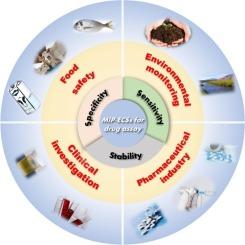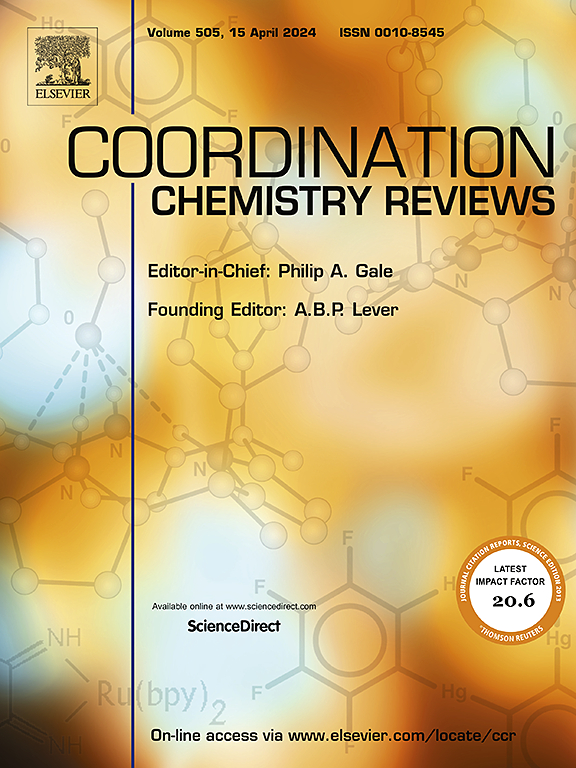The state-of-the-art of molecularly imprinted polymers based electrochemical sensors and their applications in drug assay
IF 20.3
1区 化学
Q1 CHEMISTRY, INORGANIC & NUCLEAR
引用次数: 0
Abstract
Pharmaceutical analysis holds great importance in various fields covering drug quality control, disease treatment, food safety and environmental monitoring. As a kind of artificial antibody with designed specific recognition sites, molecularly imprinted polymers (MIPs) have aroused great interest among researchers due to their remarkable merits of being customizable, reusable, and highly stable in harsh conditions. To date, MIP-based electrochemical sensors (MIP-ECSs) have been considerably reported for detecting varieties of pharmaceutical compounds, thus a systematic review is necessary to retrospect the latest development in this topic. Herein, we comprehensively review the recent progress in preparing MIPs and the novel detection strategies for improving the sensing performance of MIP-ECSs. In addition, the applications of MIP-ECSs in pharmaceutical analysis are overall investigated and reviewed, encompassing the detection of antibiotics and antivirals, anticancer drugs, psychotropic and addictive substances, and other kinds of drugs in different matrices. Finally, the potential challenges and prospectives of MIP-ECSs are discussed to further improve their detecting performance and achieve better feasibility and expanded applicability in pharmaceutical analysis.


分子印迹聚合物电化学传感器的研究进展及其在药物分析中的应用
药物分析在药品质量控制、疾病治疗、食品安全和环境监测等领域具有重要意义。分子印迹聚合物(molecular im印迹聚合物,mip)作为一种具有设计特异性识别位点的人工抗体,因其具有可定制、可重复使用和在恶劣条件下高度稳定等优点而引起了研究人员的极大兴趣。迄今为止,基于mip的电化学传感器(MIP-ECSs)已被大量报道用于检测各种药物化合物,因此有必要对该领域的最新进展进行系统的回顾。在此,我们全面回顾了最近在制备mip和新的检测策略,以提高MIP-ECSs的传感性能的进展。此外,对MIP-ECSs在药物分析中的应用进行了全面的研究和综述,包括抗生素和抗病毒药物、抗癌药物、精神药物和成瘾物质以及其他不同基质药物的检测。最后,讨论了MIP-ECSs的潜在挑战和前景,以进一步提高其检测性能,使其在药物分析中具有更好的可行性和更广泛的适用性。
本文章由计算机程序翻译,如有差异,请以英文原文为准。
求助全文
约1分钟内获得全文
求助全文
来源期刊

Coordination Chemistry Reviews
化学-无机化学与核化学
CiteScore
34.30
自引率
5.30%
发文量
457
审稿时长
54 days
期刊介绍:
Coordination Chemistry Reviews offers rapid publication of review articles on current and significant topics in coordination chemistry, encompassing organometallic, supramolecular, theoretical, and bioinorganic chemistry. It also covers catalysis, materials chemistry, and metal-organic frameworks from a coordination chemistry perspective. Reviews summarize recent developments or discuss specific techniques, welcoming contributions from both established and emerging researchers.
The journal releases special issues on timely subjects, including those featuring contributions from specific regions or conferences. Occasional full-length book articles are also featured. Additionally, special volumes cover annual reviews of main group chemistry, transition metal group chemistry, and organometallic chemistry. These comprehensive reviews are vital resources for those engaged in coordination chemistry, further establishing Coordination Chemistry Reviews as a hub for insightful surveys in inorganic and physical inorganic chemistry.
 求助内容:
求助内容: 应助结果提醒方式:
应助结果提醒方式:


